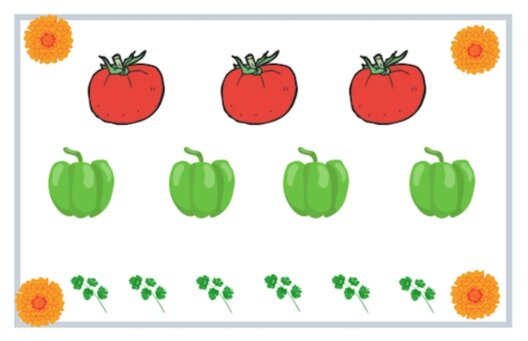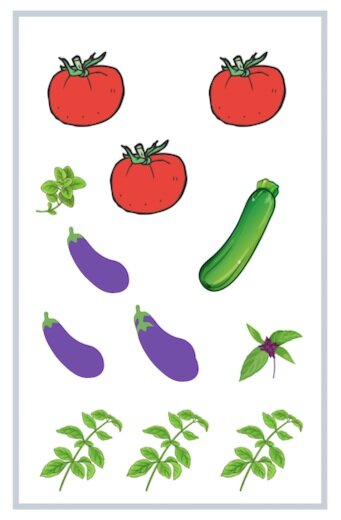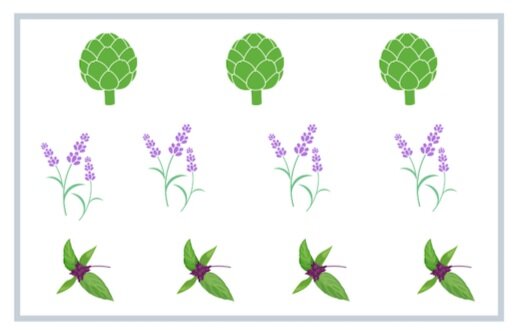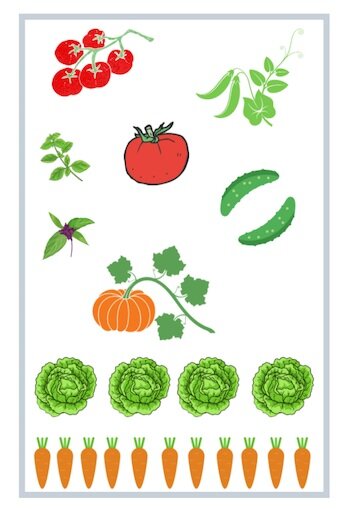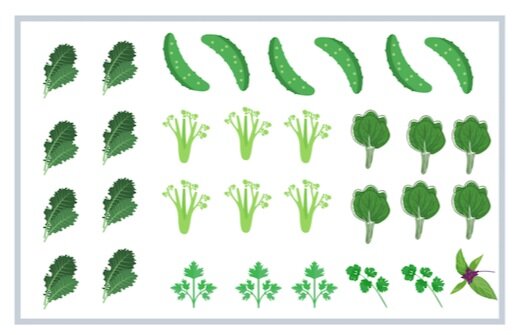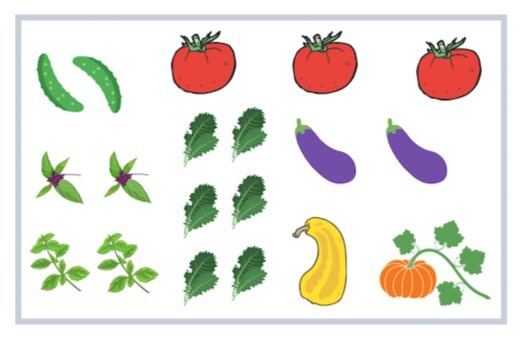There’s never been a better time to plant your edible garden. Here’s our simple guide to getting started, plus seven easy garden plans with specific plant recommendations, ranging from Salsa Gardens to Green Juice Gardens.
As a reminder, many local nurseries are still open for all of your plant, soil, and compost needs. We put together a list to help you find a garden center near you.
Want Yardzen to create a design with space for an edible garden? Get started here.
Getting Started
If you’re planting directly in the ground, your soil is likely better than you think! Many people worry that their soil is “too hard,” “too sandy,” or “too [fill in the blank],” but it’s probably better than you’re giving it credit. To prepare the ground for planting, turn over your soil to loosen it up and bring nutrients to the surface (tutorial on @yardzen_), and adding a good dose of organic material, like compost, manure, and worm castings, is likely all that you need for a bountiful edible garden.
If you’re building raised beds (here’s our favorite tutorial), you will need to purchase soil from your local garden center. This can get quite expensive, so to save money, try to find a local garden center that sells in bulk (ask if you need to bring your own bags!). It’s important to add about 25% organic matter, like compost, manure, and worm castings–use your shovel or your hands to mix! Many bagged soils, like E.B. Stone Organics Raised Bed Mix, already have all of the elements that your plants will need.
Planting Tips
Save yourself the time: seedlings, not seeds, are the way to go!
Plant deep in the ground. Make sure that the root ball and a portion of the seedling’s stem are well-covered (but not too compact!). This gives the plant excellent support and encourages vigorous root growth. (Tutorial on @yardzen_)
Pro tip: Feed your seedlings with a healthy dose of liquid seaweed. Beware of liquid fertilizers other than seaweed or kelp; unless expertly applied, they can kill your plants.
Plant your shortest plants on the eastern side of your garden bed, and your tallest plants on the western side of the garden. This ensures that all of your plants get the most sun.
Wherever possible, include pollinator-loving plants! Pollinators are essential for your edible plants.
With tomato plants, if you have limited space, look for determinate varieties, which are much more compact.
Always cage your tomatoes!
Garden Plans
Salsa Garden
Tomatoes, peppers, cilantro, and marigolds! Why marigolds? They attract pollinators, and they repel pests, like nematodes, which can wreak havoc on tomato plants. With your tomatoes, be sure to give them as much room as possible, and if they start blocking the sun from other plants, trim them back (don’t cut too much, but there’s no right or wrong way to do that).
Tomatoes: Paste tomatoes, like widely available Romas, are traditionally used in salsa. Cherry tomatoes are a personal favorite for salsa because they keep their crunch and their sweetness adds flavor complexity when mixed with the heat of the peppers and tartness of the cilantro.
Peppers: Choosing the best peppers for your garden depends on how spicy you want to go! A safe bet is a mix of bell peppers, like Big Berthas (homegrown bell peppers tend to be quite small) and jalapenos.
Cilantro: Look for slow-bolting cilantro, which is better suited to summer heat. If you can’t find slow-bolting, no problem, be prepared to replant if they go to flower.
If you have extra room, consider adding tomatillos, which are the husked tomatoes found in green salsas. Tomatillos can grow very large and should be planted in pairs (for pollination), so be sure you have ample space.
Italian Garden
This garden will keep you fed with all of the ratatouille, tomato sauce, bruschetta, caprese, and eggplant parmesan you want! With your tomatoes and zucchini, be sure to give them as much room as possible, and if they start blocking the sun from other plants, trim them back (don’t cut too much, but there’s really no right or wrong way to do that).
Tomatoes: Go for a mix of paste (Roma, San Marzano), heirloom (Brandywine, Mortgage Lifter), and cherry tomatoes–that way, you’ll have all your culinary bases covered.
Eggplant: Just about any variety of eggplant tastes delicious covered in sauce and cheese. Easy growers include Black Beauty and Japanese eggplants.
Oregano: Oregano is not only a popular herb in Italian dishes, it’s also an excellent companion plant–it deters many garden pests.
Basil: For Italian dishes, choose sweet basil, like Genovese or Italian Large Leaf. To keep the pollinators happy, we also included an African Blue Basil, a prolific and fragrant basil that’s more ornamental, although it can be used as a garnish.
Zucchini: The blessing and the curse of zucchini is that it will thrive in just about any garden. The foliage and fruit can become aggressively big, so be sure to trim back your plant and harvest the zucchini when it’s young.
Pollinator Friendly
A simple, prolific, and visually exciting pollinator garden, complete with African Blue Basil, Lavender, and Artichoke. In addition to being fantastic for pollinators, all of the plants listed here have many uses in the home. African Blue Basil looks and smells incredible as a cutting flower, lavender has a multitude of applications, and artichokes are delicious—you just have to let some of them flower to attract the pollinators!
African Blue Basil: Bees go nuts for this stuff! If you can’t find this variety, look for Tulsi, and if you can’t find that, you can use culinary basil and let it flower! Fair warning: It can grow quite large, so cut it back if you’re short on space.
Lavender: There are many types of lavender, and they are all an excellent choice for pollinators. Check out this great guide to lavender varieties.
Artichoke: Artichoke in a pollinator’s garden? Yes! You just have to let some of them go to flower. Pollinators love the purple flowers, and they add a beautiful pop of color to any garden.
Tea Garden
There is nothing quite as delicious as a homemade iced tea on a hot summer day. How does lavender and lemon verbena sound?
Chamomile: A classic for tea and easy to grow! Delicate white flowers make these a gorgeous addition to any garden.
Marjoram: Marjoram tea is said to have a whole host of benefits for tea drinkers (check it out!). It adds a deep, herbal flavor.
Mint: Mint is a vigorous grower, so be sure to cut it back!
Lemon Verbena: Just as you might have guessed, lemon verbena adds a distinctly citrus flavor to any tea.
Lavender: Lavender creates an incredible tisane and can be added to a whole host of culinary and self-care recipes.
If you have more room, consider adding: lemongrass, bergamot, calendula, anise hyssop, and bee balm.
Children’s Garden
Tomatoes: Go for a mix of heirloom and cherry tomatoes. Sun Gold and Super Sweet 100s are two cherry tomato favorites that are perfect for popping right into your mouth!
Cucumbers: Cucumbers are always a hit! Once established, they are quite easy to grow (tender seedlings can fall victim to garden pests, so it’s good to keep an eye on them). Great slicing cucumber favorites, opposed to pickling varieties, include Sweet Success, Burpless (learn more), and Spacemaster. Important: cucumbers prefer something to grow on! A trellis or a tomato cage work well.
Pumpkin: Pumpkins are one of the most fun things to grow in the garden. They’re easy, and their growing timeline feels like a Halloween countdown. Fair warning: Pumpkin plants can get HUGE, so if you’re planting in a small space, think about how you can drape the vines over the edge of an in-ground planter or raised bed.
Lettuce: Most lettuce is “cut and come again,” which means you can trim it for salad, and it will regrow. Homegrown lettuces tend to be sweet and mild, especially Bibb and Butter lettuce.
Sweet Peas: Sweet Peas are always a hit! Fast to grow, fragrant flowers, and sweet pods for eating right of the vine. Importantly, sweet peas require trellising.
Carrots: The one exception to planting seedlings is carrots. Carrots do best when planted from seeds, as planting seedlings are disruptive to growth. Follow planting directions on seed packets! A favorite seed purveyor is Renee’s Garden.
Green Juice Garden
Kale: Like most lettuce, kale is “cut and come again.” It’s incredibly easy to grow, and it’s packed with nutrients.
Celery: We’ve all heard of the celery juice crazy. Now is the time to grow it! It’s very easy to care for, but it does take a long time.
Cucumber: Slicing cucumbers, as opposed to pickling varieties, are best for juicing. Try Sweet Success, Burpless (learn more), and Spacemaster. Important: cucumbers prefer something to grow on! A trellis or a tomato cage works well.
Parsley & Cilantro: Many green juices contain these excellent detoxifiers. Look for slow-bolting cilantro.
Broccoli: Most broccoli prefers cooler temperatures, but some heat-resistant varieties will be happy during the summer!
African Blue Basil: We added one basil in the corner to keep the pollinators happy!
Dealer’s Choice
Hi! I’m Kendra, and I’m the Growth Manager here at Yardzen. I’m also an avid edible gardener. I have been gardening all of my life, and at my home in San Leandro, I have an edible front yard (photo). Here are my go-to picks for an easy edible garden.
Tomatoes: For the most part, I prefer big, red, beefsteak tomatoes, but I always include some paste and cherry tomatoes, too. My favorite varieties: Brandywine, San Marzano, German Johnson, Sun Gold, and Early Girl. I also love growing tomatillos and freezing green salsa to enjoy all winter long.
Cucumbers: We eat a ton of cucumbers in my family, so I had to include them. Great slicing cucumber favorites, opposed to pickling varieties, include Sweet Success, Burpless (learn more), and Spacemaster. Important: cucumbers prefer something to grow on! A trellis or a tomato cage works well.
Basil: One of my favorite recipes to make from the garden in pesto–I eat it on everything. To keep my pesto supplies going, I always make sure to have 2-3 basil plants in my garden. Sweet basil, like Genovese, is best. I also ALWAYS include as much African Blue Basil as will fit– it’s incredible for pollinators, looks beautiful in phases, and smells heavenly.
Squash: My go-to squash varieties are Delicata and Butternut. They are easy growers and store for months. We like to roast them and make soups throughout the winter.
Eggplant: I could eat eggplant several times a week. It’s an excellent meat substitute in many types of cooking, like Italian, Indian, and Thai. I like to grow both Black Beauty and Japanese eggplants. They both work well in all cuisine.
Kale: Like most lettuce, kale is “cut and come again.” It’s incredibly easy to grow, and it’s a favorite of mine for sauteing (it’s also our pet chickens’ favorite!).
Pumpkins: I LOVE growing pumpkins. Seeing them mature is always a fun reminder of fall and Halloween. They are easy to grow but require a lot of room. I like to drape them over the edges of my raised beds. I grow a mix of small pumpkins, like Sugar Pies, which are perfect for cooking, and giant pumpkins, like Big Ben, which make lovely front porch decor.
Featured Articles
6 Small Yard Designs: Our Favorite Layouts for Your Tiny Space

Fall & Winter Edible Garden Checklist

Front Yard Edible Garden Design for a Bay Area Bungalow

Elegant, Edible Landscaping for a 300-Year-Old Barn in Hudson Valley

